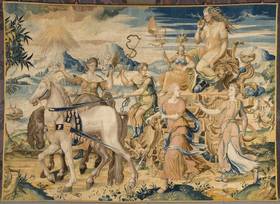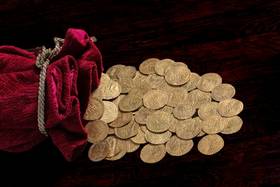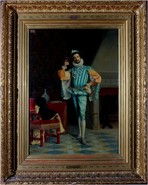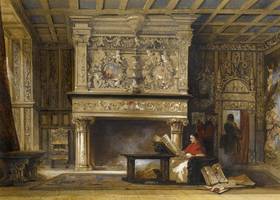- Home >
- Royal chateau of Blois >
- Collection >
- Acquisitions
Acquisitions
The Royal Chateau of Blois is a museum of France one of whose missions consists in continuing to acquire new objects so as to ensure their conservation, study and presentation to the public. To select the most remarkable works that are at once relevant to the Château and that deserving of inclusion in the heritage collections, museums submit their acquisition projects to a regional scientific commission reporting to the French culture ministry. You will find below a selection of the Chateau's most recent acquisitions:
Purchase of a tapestry: The triumph of Envy, mother of war

 In 2012 the Royal Chateau of Blois, which possessed no tapestry comparable to that of the Valois, decided to buy this rare item that had no doubt originated in the Royal Manufactures. It illustrates not only the Renaissance predilection for allegory and antique scenes of triumph, but also the way models circulated between the Netherlands, Italy and France. The model exhibited reproduces a drawing by Martin Van Heemskerck (1498-1574), a Dutch painter who lived in Haarlem. The tapestry may be seen in the Valois room.
In 2012 the Royal Chateau of Blois, which possessed no tapestry comparable to that of the Valois, decided to buy this rare item that had no doubt originated in the Royal Manufactures. It illustrates not only the Renaissance predilection for allegory and antique scenes of triumph, but also the way models circulated between the Netherlands, Italy and France. The model exhibited reproduces a drawing by Martin Van Heemskerck (1498-1574), a Dutch painter who lived in Haarlem. The tapestry may be seen in the Valois room.
Silk and wool tapestry, 16th century (Inv. 2012.2.1.), acquired by the town of Blois with the help of the FRAM and the Amis du chateau
Donation of a monetary treasure (medieval and Renaissance gold coins)

 A true treasure trove, these 67 pieces of gold unearthed in Montargis in 1962 essentially consisted of Renaissance currency buried during the Wars of Religion. Indeed, the most recent of these « ecus » is dated 1587, year of the showdown in the Gâtinais region between Protestant troops and the Catholic troops commanded by the Duke of Guise. The Royal Château of Blois did not previously possess any Renaissance gold coins. In contrast with silver coinage issued with an effigy of the king, the gold coins were solely emblematic or iconic. This treasure is now exhibited in the Valois room.
A true treasure trove, these 67 pieces of gold unearthed in Montargis in 1962 essentially consisted of Renaissance currency buried during the Wars of Religion. Indeed, the most recent of these « ecus » is dated 1587, year of the showdown in the Gâtinais region between Protestant troops and the Catholic troops commanded by the Duke of Guise. The Royal Château of Blois did not previously possess any Renaissance gold coins. In contrast with silver coinage issued with an effigy of the king, the gold coins were solely emblematic or iconic. This treasure is now exhibited in the Valois room.
Monetary treasure (Inv. 2014.4.1 to 2014.4.67), donation of the Banque CIC-Ouest
Donation of a painting by Henri Coroenne: "To the King's health" (1874)

 A painter of historical figures, in this portrait Coroënne produced an anecdotal representation of an alluring Henri III. With his dazzling palette of warm colors and his smooth and mellow texture, the artist imbues with vitality a personage who seems to be toasting the spectator. Just like many other 19th-century historical portrait painters, he viewed the reign of Henri III as a sumptuous time, an epoch in which fun and feasts proceeded at a pace as frantic as plots and crimes. The Royal Chateau of Blois has conserved two other works by this artist: The portraits of Monsieur and Madame Valere Lefebvre.
A painter of historical figures, in this portrait Coroënne produced an anecdotal representation of an alluring Henri III. With his dazzling palette of warm colors and his smooth and mellow texture, the artist imbues with vitality a personage who seems to be toasting the spectator. Just like many other 19th-century historical portrait painters, he viewed the reign of Henri III as a sumptuous time, an epoch in which fun and feasts proceeded at a pace as frantic as plots and crimes. The Royal Chateau of Blois has conserved two other works by this artist: The portraits of Monsieur and Madame Valere Lefebvre.
Oil on canvas (Inv. 2013.3.1), donation from the Amis du Chateau
Donation of a Muller watercolor: The Chamber of Marie de Medici in the chateau of Blois (1841)

 A landscape painter from the Bristol School of Artists, in 1840 Muller came to France to produce illustrations of the Renaissance. This watercolor is of particular interest inasmuch as it provides an inside view of the Château of Blois prior to the rehabilitation undertaken by Duban. It informs us on the condition of the interior decor of the chamber of the king, and corroborates the hypothesis that in 1841, the door and the fireplace still existed. The watercolor also confirms the fact that Duban's designs depict the fireplace before it was restored.
A landscape painter from the Bristol School of Artists, in 1840 Muller came to France to produce illustrations of the Renaissance. This watercolor is of particular interest inasmuch as it provides an inside view of the Château of Blois prior to the rehabilitation undertaken by Duban. It informs us on the condition of the interior decor of the chamber of the king, and corroborates the hypothesis that in 1841, the door and the fireplace still existed. The watercolor also confirms the fact that Duban's designs depict the fireplace before it was restored.
Watercolor on paper (Inv. 2014.1.1), donation from the Amis du Chateau









